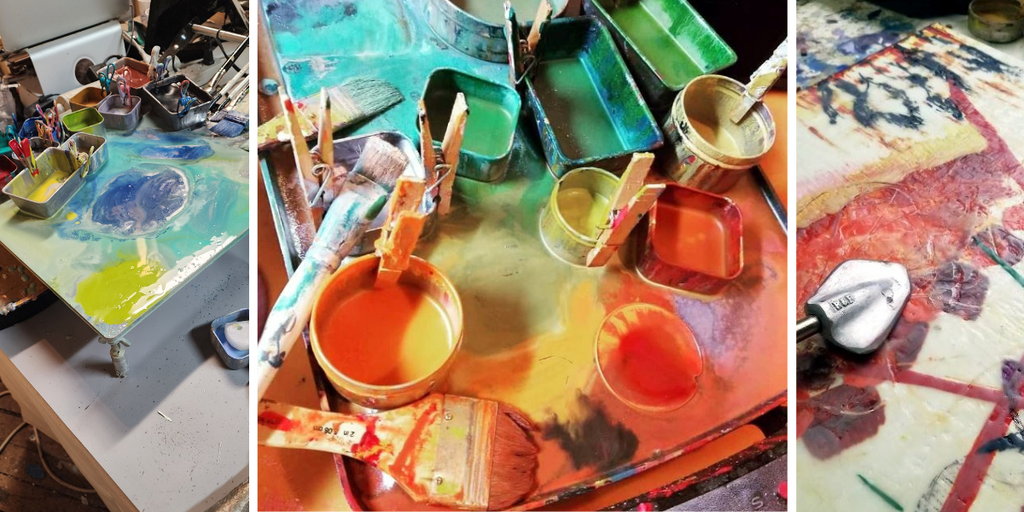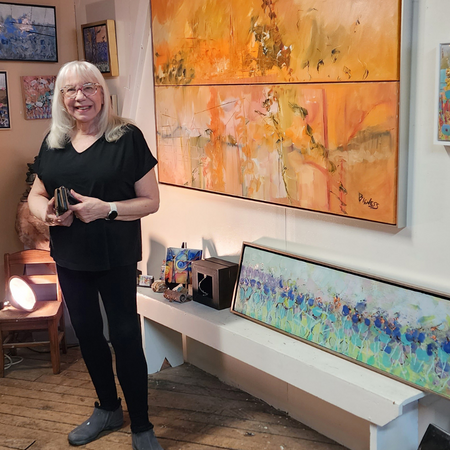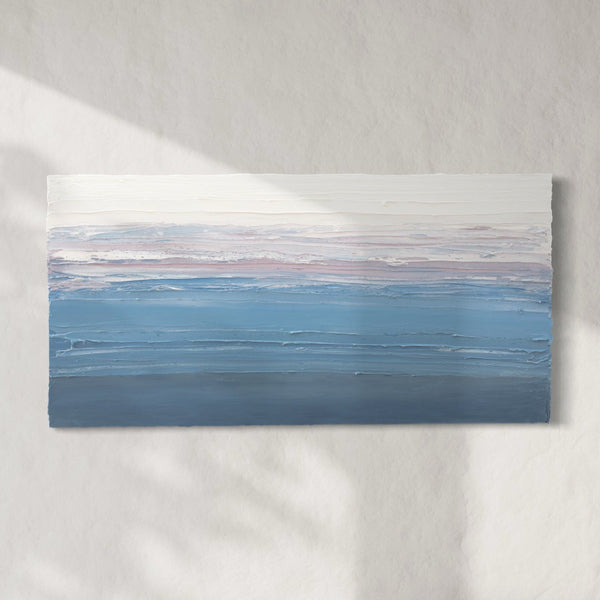Based in Central New York, Linda Bigness is a fine artist who specializes in encaustic painting, a lesser-known medium which incorporates beeswax, resin, and heat. The result? A painting with subtle texture and a luminous finish. We dove in to the subject of encaustic painting with Linda, to find out more about how she got started in such a unique practice, what she loves about the medium, and how her external influences and chosen medium play off of one another. Read on to learn about Linda Bigness, her creative process and evolution as an encaustic artist.
Our Talk with Linda
Tell us about yourself! Where are you from, where are you located now?
I was born in Detroit and eventually migrated with my family to Central New York, where I pursued my love of art with three degrees in painting, fine arts, and art history from Syracuse University.
How would you describe your artwork?
Sometimes it is difficult to categorize a style in art. However, I think my art is predominantly abstract with influences from the natural world. Sometimes it takes on an impressionist feel as I take color, shapes, and lines from reality. My first impression usually takes shape by drawing the first lines I see.

What is encaustic painting?
Encaustic means to “burn in”, from the Greek word enkaustikos. This name comes from the fact that in encaustic painting, each layer must be fused with heat to the layer beneath it. The base medium used in encaustic painting is primarily made from beeswax. The wax is mixed with damar resin which is crystallized sap from fir trees. The damar resin provides hardness while the wax provides luminosity. Encaustic art can be made with only this clear combination or mixed with high-quality pigments. An encaustic “purist” will tell you that true encaustic painting must involve pigment, but I would disagree because I even love the qualities of just the clear beeswax.
Encaustic painting is often combined with other media like photography, other types of paint, and collage. They are coveted due to their luminosity, rich texture, and natural, aromatic smell.
How did you get started with this medium? Did you always use it or did it come later in your career as an artist? What ultimately drew you to it?
Around the year 2000, I took a trip to Wales where I learned about my grandfather who was a glass blower in Swansea. During this trip, I discovered an art colony which was engaged in encaustic painting. I decided that I definitely would pursue this painting medium after returning to America. My main medium of choice is oil paint, and learned quickly that I could incorporate this medium into the encaustic medium to create luminous and layered transparent art. I’ve taken several workshops and attended many residencies. One memorable one was a residency fellowship at the Vermont Studio Center where I met the well-known woman artist and encaustic painter, Michelle Stuart. Her critiques were encouraging, and helped with my self-directed pursuit of learning the medium.

Was there a significant learning curve for you when you started using it, or did it come easily to you?
This medium is not for the faint of heart and does take some precautionary set-up to be successful and safe. I learned quickly that ventilation and careful consideration of the materials was very important. Of course, much of this information was not readily available twenty years ago, and it took a lot of research to get the answers. Since that time, many books have been written, and now we have Youtube, to help the artist obtain the skills needed. But it wasn't easy in the beginning, as I had to learn to be very patient with the medium and with myself.
How does your chosen medium inform your work?
Often, the layering and drawing of images work to inform the history of the work. Each work can be compared to writing a journal. Each mark informs the next to create an expression of what I am interested in. For example, my love of trees often appears in the work and will evolve throughout the process.
What’s your favorite thing about encaustic painting as a medium, as it factors into your process?
The hot molten wax and the way it forms into a glass-like surface when heated with a torch.
What’s the biggest challenge working with this medium?
Working on large panels can be a challenge due to the weight. As you add wax the support gets heavier. I often use oil pigment sticks, as well, to incorporate drawing into the piece, and the oil can take a very long time to dry or set. Again, patience is important.
Can you walk us through your creative process?
The work always begins with the drawing. This drawing at the base of the painting can be obliterated over time under several layers of wax medium and paint. This is the process that I enjoy the most. It reminds me of writing a journal with one thought or mark informing the next as I work toward the surface. There is something very satisfying about working this way. I am always looking back through the process to discover the real meaning.

What inspires you?
Nature and its constant renewal always inform my thought process. Humanity does too sometimes, but more often it is nature that speaks to me.
Are there any particular artists who have inspired you or to whom you feel connected in some way?
With a Master’s degree focused on Art History, I could go on and on about all the artists in history and their influence on my work. However, my greatest connection has always been the work of Paul Klee. He drew simple childlike images and made them into masterful works of art. I think the simplification of the image and his connection with the natural world and music greatly affected my creative process.
From your first painting to those you create now, how would you say you’ve grown as an artist?
I am no longer afraid to create and no longer fear the results. Throughout my lifetime, I’ve grown to accept my unique voice and allow it to be seen.
If you could give one piece of advice to yourself as a younger artist, what would it be?
Work every day, either in your mind or physically, pushing around the ideas. Keep a journal and don’t be afraid of your inner voice.
Taking a broader view, what is your goal as an artist?
I would like to leave the universe a body of work that is recognized as coming from an artist who was inspired and had a great love of the creative process.
Tea or coffee?
Coffee.
Morning person or night owl?
Both.
Books or movies?
Books.
Mountains or beach?
Mountains.
A fun fact about you?
I like to drive to places I have never been and explore. I don’t mind getting lost.
Finally: What’s your favorite place on earth?
Underwater, exploring a coral reef.
Linda Bigness is an internationally exhibited artist who maintains a gallery/studio in Syracuse, New York. Her work has been exhibited in several prestigious solo and group shows that have involved notable jurors such as art critic Clement Greenberg, Ivan Karp, director of OK Harris Gallery in NYC, and Tom Piche, director of the Daum Museum of Contemporary Art. In addition, Bigness’ large scale paintings are often selected and commissioned for corporate and residential clients, including the Turning Stone Resort, Merrill Lynch Corporation, Haylor, Freyer and Coon, and Bausch and Lomb.
Presently she is working on her latest book and exhibition about abstract art and the contemporary processes used by working artists today. Part of the research for this book is taken from the workshops she teaches and her oil painting and mixed media collage experience. For over 30 years Bigness has used her expertise to share with others the unique beauty and processes of her chosen medium through writing, teaching and professional exhibits.
Her first book, “Paint It, Tear It, Create It,” offered the reader insight into visual abstract thinking through the process of collage and painting. She continues to explore the abstract through surface manipulation using encaustics and oil and is currently working on a new series, the “Journey Stones Revisited,” that reflects her extensive travels through the United States and Europe.
To learn more about other Sorelle artists with unique media, read our Spotlight on Unique Materials here. To see all artwork by Linda Bigness, including original encaustic paintings and prints, visit her Artist Collection.
Want to purchase a piece? Contact us for a custom invoice or add it to your cart and checkout online!



0 comments
Post a comment